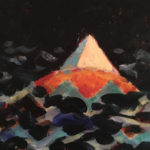In this episode, I have edited and shortened the original document of the Plutarch version of the story I was using. Many parts of the Plutarch version of the story don’t have evidence on walls or on papyrus, the Pharaonic evidence. The important thing about researching ancient Egypt is that you can see what they have said themselves and not be totally dependent on someone else’s ideas or interpretations.
REVENGE AND INHERITANCE continued
“And the chest is mine!”
“It is yours indeed, and shall be so forever!” hissed Seth as he banged down the lid. Then in desperate haste he and the conspirators nailed it shut and sealed every crack with molten lead, so that Osiris the man died in the chest and his spirit went west across the Nile into Duat the Place of Testing; but not beyond it to Amenti, where those who have passed the judgments of Duat [the underworld] live for ever. [1]
Seth and his companions took the chest which held the body of Osiris and cast it into the Nile. Hapi, the Nile-god, carried it out into the Great Green Sea [the Mediterranean Sea] where it tossed for many days until it came to the shore of Phoenicia near the city of Byblos. Here the waves cast it into a tamarisk tree that grew on the shore; and the tree shot out branches and grew leaves and flowers to make a fit resting place for the body of the good god Osiris and very soon that tree became famous throughout the land. [2]
By now the branches had grown together and hidden the chest which held the body of Osiris in the trunk itself. A local king cut down the tree and fashioned it into a great pillar for his palace. No one knew that it held the body of a god.
Meanwhile in Egypt Isis was in great fear. She had always known that Seth was filled with evil and jealousy, but kindly Osiris would not believe in his brother’s wickedness. Isis fled into the marshes of the delta carrying the baby Horus with her. [3]
She found shelter on a little island where the goddess Buto [cobra snake – Udjat] lived, and entrusted the divine child to her. And as a further safeguard against Seth, Isis loosed the island from its foundations, and let it float so that no one could tell where to find it.Then she went to seek the body of Osiris. For, until he was buried with all the needful rites and charms, even his spirit could go no farther to the west than Duat, the Testing-Place; and it could not come to Amenti.
Back and forth over the land of Egypt wandered Isis, but never a trace could she find of the chest in which lay the body of Osiris. She asked all whom she met, but no one had seen it – and in this matter her magic powers could not help her.
At length Isis heard the story of the tree and gained employment with the queen of the palace. The queen asked her to serve in the palace and tend her children, one who was ailing sorely. She did not know that the strange woman who was wandering alone at Byblos was the greatest of all the goddesses of Egypt.
Isis agreed to this, and very soon the baby was strong and well though she did no more than give him her finger to suck. But presently Isis became fond of the child, and thought to make him immortal, which she did by burning away his mortal parts while she flew round and round him in the form of a swallow. The queen, however, had been watching her secretly; and when she saw that her baby seemed to be on fire she rushed into the room with a loud cry, and so broke the magic. Then Isis took on her own form, and Astarte crouched down in terror when she saw the shining goddess [4] and learned who she was.
The king and queen offered her gifts of all the richest treasures in Byblos, but Isis asked only for the great tamarisk pillar which held up the roof, and for what it contained.
When Isis opened the chest she let out such a terrible cry of sorrow that a small child was said to have died at the very sound. After this she came safely back to Egypt and hid the chest in the marshes of the delta while she hastened to the floating island where Buto was guarding Horus. [5]
But it chanced that Seth came hunting wild boars with his dogs, hunting by night after his custom, since he loved the darkness in which evil things abound. By the light of the moon he saw the chest of cedar wood inlaid with ebony and ivory, with gold and silver, and recognized it. He tore open the chest, took the body of Osiris, and rent it into fourteen pieces and with his divine strength, he scattered them up and down the whole length of the Nile so that the crocodiles might eat them. [6]
“It is not possible to destroy the body of a god!” cried Seth. “Yet I have done it – for I have destroyed Osiris!” His laughter echoed through the land, and all who heard it trembled and hid.
Now Isis had to begin her search once more. This time she had helpers, for Nephthys left her wicked husband Seth and came to join her sister. And Anubis, the son of Osiris and Nephthys, [7] taking the form of a jackal, assisted in the search.
Slowly, piece by piece, Isis recovered the fragments of Osiris. And wherever she did so, she formed by magic the likeness of his whole body and caused the priests to build a shrine and perform his funeral rites. And so there were thirteen places in Egypt which claimed to be the burial place of Osiris.
One piece only she did not recover, for it had been eaten by a fish. [8] Isis, however, did not bury any of the pieces in the places where the tombs and shrines of Osiris stood. She gathered the pieces together, rejoined them by magic, and by magic made a likeness of the missing member so that Osiris was complete. Then she caused the body to be embalmed and hidden away in a place of which she alone knew. And after this the spirit of Osiris passed into Amenti to rule over the dead until the last great battle, when Horus should slay Seth and Osiris would return to earth once more.
…to be concluded….
NOTES
Note 1:
This describes the first use of a sarcophagus, the coffin designed for preserving the body on its trip through the underworld to the afterlife. Osiris is alive when he is put in the box. As this story is symbolic, it is important to keep this in mind. The standard Egyptology view is that the Pyramid of Khufu and all other tombs were built for dead men. I can find no Pharaonic evidence for dead men making this journey into the afterlife.
Note 2:
Edited from this point in the story to leave out some unnecessary detail.
Note 3:
In the Pharaonic version, Horus is not born yet.
Note 4:
Reference to an akh – the shining one.
Note 5:
In the Pharaonic version at Abydos, one wall has Osiris manipulating his penis and on the other wall Isis, in the form of a sparrow-hawk, inseminates herself with the sperm of Osiris and conceives Horus.
Note 6:
In some versions, rather than fourteen there were forty two pieces – the same number as the districts (nomes) that Upper and Lower Egypt were divided.
Note 7:
Nephthys used some form of trickery to consort with Osiris and conceive Anubis.
Note 8:
The Pharaonic evidence does not support the loss of Osiris’ penis to a fish.
If you wish to read the whole story by April McDevitt, it is available here: Ancient Egypt: the Mythology – The Story of Isis and Osiris
There is one more episode to relate. It is interesting to note that the version by Plutarch contains such different interpretations of the facts. This is why it is important to seek out the actual evidence.
In the Introduction to The Book of The Dead, Dr. Ogden Goulet says “It should be borne in mind that there often can be more than one interpretation, and we should beware of overconfidently imposing our conceptions upon Egyptian religion.”



